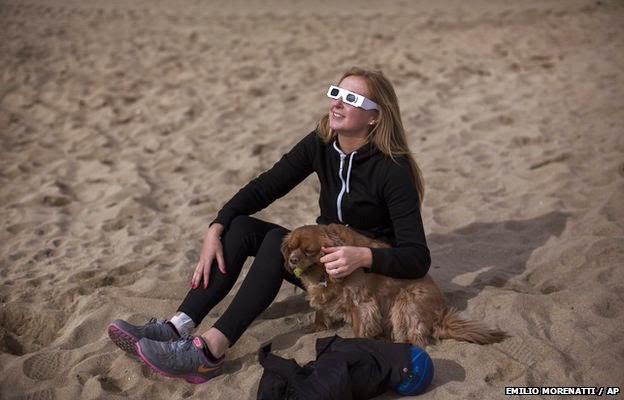Millions of people in the UK and northern Europe have glimpsed the best solar eclipse in years.
In a solar eclipse, a swathe of the Earth is plunged into
darkness as the Moon comes between us and the Sun.
From an aeroplane above the Faroe Islands, a BBC camera
captured startling footage of the event reaching totality at 09:41 GMT.
The deep shadow formed first in the North Atlantic and
then swept up into the Arctic, ending at the North Pole.
People keen to catch a glimpse of the rare phenomenon were
advised not to look directly at it.
This is because even during the eclipse, looking directly
at the Sun causes serious harm - but there are ways to watch the eclipse safelyand
many people took the chance to do so.
In all parts of the UK the eclipse reached at least 83% and the darkness peaked at about 09:35
GMT. The precise timing and degree of the eclipse varied with location.
For the Shetland Islands, the eclipse peaked at 09:43 GMT
and was very near total, with 97% of the Sun's disc obscured by the moon.
Clear viewing opportunities were restricted by the cloud
cover that shrouded much of the UK, which will not see a solar eclipse on this
scale again until 2026.
Experience a genuine total eclipse required going further
north - such as the trip taken by a BBC camera operator above the clouds in the
Faroes.
The National Eclipse Weather Experiment (NEWEx) asked people to
record conditions at their locality.
Prof Giles Harrison explained: "This is the first big
partial eclipse to happen in the UK since 1999, and the next one isn't until
August 2026, so this is a once-in-a-generation opportunity.
"By observing what happens on Friday we are
effectively turning the skies of Britain into a giant weather lab, giving us a
rare chance to see what happens when you 'turn down the Sun'.
"This will give us a precious insight into how the
Sun influences the clouds and wind, as well as more obvious effects, such as
temperature.
"By improving our understanding of how the weather
works, we're better able to predict it, meaning scientists can further improve
weather forecasts."
One phenomenon the experiment hopes to investigate is the
"eclipse wind". This refers to changes in the breeze that eclipse
observers have reported as darkness falls.
Oxford University scientists, meanwhile, are using the event to
try to understand how eclipses affect electricity grids.
The deep shadow will have reduced the output from solar
panels, which now supply a significant proportion of power needs right across
Europe.
The researchers will look to see how this dip in
performance impacted the stability of grid networks.
Next year will have a total solar eclipse, too.
That will occur on 9 March, and will cross Sumatra,
Borneo, Sulawesi, and extend out over the Pacific.





No comments:
Post a Comment
beloved readers drop your comments here.